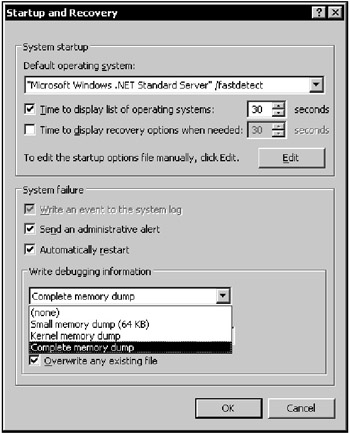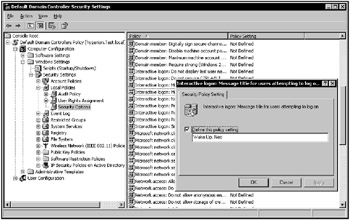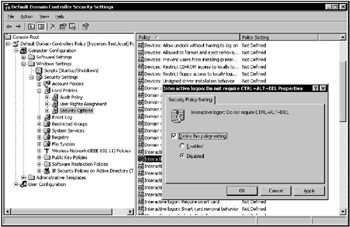Customizing the Login Process
|
|
The standard login process can be customized by editing the registry. The procedures described in this section are also applicable for Windows NT 4.0, Windows 2000, Windows XP and Windows Server 2003.
Specifying the Custom Logo Displayed at Login Time
This tip is useful for each of Windows NT/2000, Windows XP and Windows Server 2003. You can change the screen logo used as a background for the login dialog. Any BMP file can be used for this purpose (for example, a custom logo or any graphic file). To introduce this modification, you need to do the following:
-
Start the registry editor and expand the HKEY_USERS\.DEFAULT\Control Panel\Desktop registry key.
-
Find the Wallpaper value entry, and specify the path to the BMP file that you want to use as a background for the login dialog (Fig. 4.11).

Figure 4.11: To specify the custom logo displayed at login time, edit the Wallpaper value under HKEY_USERS\.DEFAULT\Control Panel\Desktop
| Note | This tip will also work for Windows XP, but only if you disable the Welcome screen, which by default, is enabled. To disable the Windows XP Welcome screen, open the Control Panel window, start the User Accounts applet, click the Change the way users log on or off option, and clear the Use Welcome screen checkbox. Note that you can customize the Windows XP Welcome screen itself by adding or removing user accounts to it. To do so, simply expand the HKEY_LOCAL_MACHINE\SOFTWARE\Microsoft\Windows NT\CurrentVersion\Windologon\SpecialAccounts\UserList registry key. Add the value REG_DWORD data type, name it as required, and set the value to 0. This account will be hidden from the Welcome screen. If you want to make the account visible again set the value to 1, and it will appear on the Welcome screen. For example, if you want the Administrator account (which is hidden by default) to appear on the Welcome screen, create the REG_DWORD value, name it Administrator, and set it to 1. |
Adding a Custom Message to Be Displayed at Login Time
You can also add custom messages to be displayed for all users at login. If you make this change, a small message box containing the custom message text and an OK button will appear when the user logs on to the system. The boot process will continue as usual after the user clicks the OK button. You can find tips on this both in Internet forums and in other books. However, there's a much easier and safer method of performing this customization. In Windows NT 4.0, you can use the System Policy Editor tool that is supplied with Windows NT 4.0 Server. In Windows 2000, Windows XP and Windows Server 2003, you can use either the Local Security Policy snap-in (for systems participating in workgroups) or the Group Policy snap-in (for systems joined to domains). In this section, we'll cover different ways of adding a custom message, both by using administrative tools and by editing the system registry directly.
Adding a Custom Login Message Using the Local Security Policy Snap-in
To create a custom login message, proceed as follows:
-
Start the Administrative Tools applet in Control Panel. For standalone systems or systems participating in workgroups, select the Local Security Policy option. For systems participating in domains, use Group Policy. Expand the Security Settings hierarchical list by selecting Local Policies | Security Options. The right pane of the MMC window will display the system policies that can be specified for the local system.
-
Double-click the Interactive logon: Message text for users attempting to log on option, or right-click this option and select the Properties command. The Interactive logon: Message text for users attempting to log on window will appear (Fig. 4.12).

Figure 4.12: Using MMC for specifying a custom login message (Windows Server 2003 domain controller) -
Fill in the text field in this window with your custom message text and click OK. To specify the text for the title bar caption, select the Interactive logon: Message title for users attempting to log on option.
Chapter 10 contains more detailed information on using system policies.
Adding a Custom Logon Banner by Editing the Registry Directly
To specify a custom logon banner by direct registry editing, proceed as follows:
-
Open the HKEY_LOCAL_MACHINE\SOFTWARE\Microsoft\WindowsNT\CurrentVersion\WinLogon key.
-
Find the LegalNoticeCaption value entry. Edit its value to specify the phrase that will be displayed as the caption in the custom-message box.
-
Next, open the LegalNoticeText value entry and edit its value to specify the text of your custom message.
| Note | In Windows XP and Windows Server 2003, the LegalNoticeCaption and LegalNoticeText values were moved to the following registry key: HKEY_LOCAL_MACHINE\SOFTWARE\Microsoft\Windows\CurrentVersion\policies\system. These are the registry values that are set when you use Local Security Policy or Default Domain Controller Security Settings snap-ins. Values with the same names also exist under HKEY_LOCAL_MACHINE\SOFTWARE\Microsoft\WindowsNT\CurrentVersion\WinLogon. However, the LegalNoticeCaption and LegalNoticeText Values Under HKEY_LOCAL_MACHINE\SOFTWARE\Microsoft\Windows\CurrentVersion\policies\system have priority, and if they are set, the values under the Winlogon registry key will have no effect. |
Automating the Logon Process
In contrast to Windows 9x/ME, the logon procedure used in all Windows NT-based operating systems is an integral part of the security subsystem. However, there may be times when you want to automate this procedure so that other users can start your computer and use the account you establish for automatic logon.
| Note | Note that enabling the Autologon feature, however convenient it may seem, also involves a security risk. Setting a computer for Autologon means that anyone who can physically obtain access to the computer can gain access to all of the computer's contents, including any network or networks to which it is connected. Any users who have logged on remotely can view and read it. Therefore, this option is not available in the UI for server platforms (for example, you can't configure Windows 2000 Server or Windows Server 2003 to use Autologon). The automatic logon feature is also unsupported when you log on to a domain and, therefore, you must join a workgroup to use this feature. However, if your computer belongs to a Windows 2000 or Windows Server 2003 domain, you can still enable automatic logon by editing the registry (in this case, however, doing so is highly risky and undesirable). |
To add logon information using Regedit.exe
-
Start Regedit.exe and locate the following Registry subkey:
HKEY_LOCAL_MACHINE\SOFTWARE\Microsoft\WindowsNT\ CurrentVersion\Winlogon
-
Locate the DefaultUserName entry, and set its value to the user name that you want to be logged on automatically.
-
If the DefaultPassword value does not exist, create a new value entry of the REG_SZ data type, rename it to DefaultPassword, and specify the default password as its value.
-
If the AutoAdminLogon value entry doesn't exist, create a new value of the REG_SZ data type, rename it AutoAdminLogon, and set its value to 1.
-
Save your changes, and then exit Regedit.
-
Shut down and restart your computer.
When you restart the computer, the default user will be logged on automatically.
| Note | Note that the AutoAdminLogon is a REG_SZ type value entry, not a REG_DWORD registry value entry. Also note that, in order to enable automatic logon, you need to disable the Interactive logon: Do not require CTRL+ALT+DEL Local Security Setting (Fig. 4.13). |

Figure 4.13: To enable automatic logon, the Interactive logon: Do not require CTRL+ALT+DEL local security setting must be disabled
Hiding the Last User Name Logged On
In the previous section, we discussed a setting that weakens your security system and exposes it to risk. Now we are going to discuss a method that will allow you to strengthen security. When the standard Windows NT/2000/XP or Windows Server 2003 configuration is used, the system displays the name of the user who last successfully logged. If you hide this name, the security rules will become more restrictive, since guessing both the user name and password is more difficult. This customization is one of the most frequently made. As you can guess, it also requires that you to add a new value to the registry. To hide the user name from the last log on, proceed as follows:
-
Run Regedit.exe and open the following key: HKEY_LOCAL_MACHINE\SOFTWARE\Microsoft\Windows\CurrentVersion\policies\system.
-
Add the DontDisplayLastUserName value and specify the REG_DWORD data type for it.
-
Set this entry to 1. When you next log on to the system, the name of the user who logged on last won't be displayed. If you need to disable this feature later, set this value to 0.
| Note | You can carry out the same task using MMC snap-ins to edit the Interactive Logon: Do not display last logged on user name local security setting. Note that the same effect can be produced by setting a value with the same name under HKEY_LOCAL_MACHINE\SOFTWARE\Microsoft\WindowsNT\CurrentVersion\WinLogon. However, the settings under HKEY_LOCAL_MACHINE\SOFTWARE\Microsoft\Windows\Currentversion\policies\system have priority, and if they are set, the same value under the Winlogon key has no effect. |
|
|